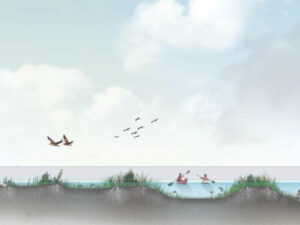Vulnerability Assessments: A Pathway to Coastal Resilience
At Freese and Nichols, we are dedicated to helping our coastal clients safeguard their communities through various measures, including comprehensive vulnerability assessments. These assessments are crucial for identifying and mitigating risks associated with coastal flooding, sea level rise, storm surge, heavy rainfall and other severe weather events. Recent events, such as Hurricanes Helene and Milton, have underscored the importance of these assessments.

Before Helene or Milton impacted the Gulf Coast of Florida, Freese and Nichols had completed a vulnerability assessment of St. Petersburg’s Southwest Water Reclamation Facility. Based on the vulnerability assessment, the utility staff presented a clear plan to the City, outlining proactive measures to create a path to climate resilience for the facility.
Craig Wells, our Client Services Manager in Florida, specializes in evaluating coastal facilities for vulnerability to storm surge, compound flooding and projected sea level rise. He develops a suite of resilience solutions tailored for the individual facility, providing the owner with guidelines to create a “climate resilient” facility that will withstand events like Helene and Milton and the stronger storms that are projected to impact coastal communities over the coming years. Craig has led climate vulnerability assessments for 29 coastal facilities, including the recent Southwest Water Reclamation Facility and the Bethune Point Water Reclamation Facility for the City of Daytona Beach.
Freese and Nichols recently completed a vulnerability assessment for St. Petersburg’s Southwest Water Reclamation Facility. Our team looks at sea level rise and storm surge projections over each facility’s lifespan, which is typically 30 to 50 years.
“We look at sea level rise and storm surge projections over each facility’s lifespan, typically 20 to 50 years,” Craig explained. “We assess potential damages if no action is taken and conduct benefit and cost evaluations for various resilience measures. These measures often include constructing berms or walls with pumping stations to protect facilities. The goal is to develop a roadmap to resiliency for the facility, which can also serve as a document to secure funding for necessary resilience measures.”
 Freese and Nichols’ funding group has secured approximately $2.2 billion in grants over the last six years for infrastructure projects for its clients. Coupled with our vulnerability assessments, we can help clients identify risks and secure the necessary funding to implement resilience measures.
Freese and Nichols’ funding group has secured approximately $2.2 billion in grants over the last six years for infrastructure projects for its clients. Coupled with our vulnerability assessments, we can help clients identify risks and secure the necessary funding to implement resilience measures.
Incorporating resilience design features into new projects further demonstrates our commitment to climate resilience.
By effectively implementing targeted resilience measures and timing their completion, Freese and Nichols’ comprehensive approach aims to build resilient communities prepared for future challenges.





